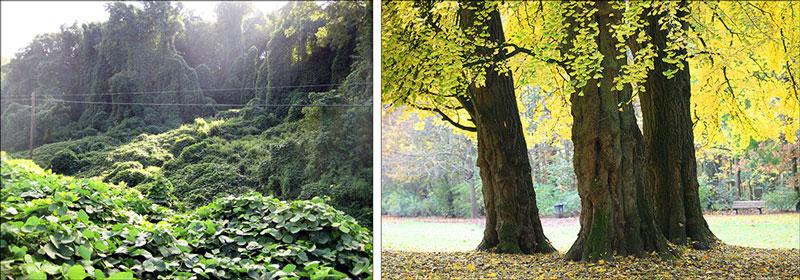Invasive Species: Understanding the Characteristics
By William M. Fountain
Green industry professionals are often asked the name of their favorite plant. Without hesitation many reply, “Ahhh, the next one I discover.” The excitement of introducing new species into landscapes is a double edge sword. It has resulted in plants like bush honeysuckle and kudzu that have escaped and degraded natural systems. Other species like ginkgo and zelkova can turn inhospitable urban sites into green oases without being invasive. What are the biological characteristics that make some species invasive? Can we use these characteristics to select species that will provide us with environmental benefits without becoming problems?

Selection criteria for horticultural plants must be more than a quest for the new, the different, the unusual. Species diversity in urban designs must be the first objective for healthy plantings. Monocultures are more likely to be killed or degraded by diseases and insects. The second objective must be that plant species function in the human environment without detrimental impacts to natural systems.
Both native and alien species can be invasive. Invasive plants are anything that is perceived as being unwanted, problematic or with the potential to crowd-out other, more desirable species. Native and alien are more difficult to define and are usually associated with a date such as 1492 for North America. Native species are those which are and have been growing in an area as a result of natural processes. Through geologic history, the environment is always changing. As we enter a new period of climate change, plants and animals are still establishing an equilibrium after the end of the last ice age. Alien species are those that have been introduced as a result of human activities. Naturalized species are alien species, introduced by humans that are now reproducing naturally.
Humans are the driving force allowing the introduction of potentially invasive species. The good news is that only a very small percentage of introduced plants ever become problematic invasive species. Only a fraction, estimated to be 10% of plants ever escape cultivation. Of these “escapes,” approximately 90% would cease to exist once they pass out of cultivation. This 1% of the total that has escaped cultivation and can be expected to continue to reproduce are known as “casuals.” Of the casuals, only an estimated 10% become truly problematic pests. (Thompson, 2014). While the estimated 0.1% of cultivated plants becoming problematic invasives is very small, the consequences can be significant. Most of the problematic invasive plant species have a number of characteristics in common, including:
- being native to another continent
- other members of the genus or family are recognized as invasive
- they are monotypic (only member of its genus or family)
- widely adapted to a variety of cultural conditions
- touted as being disease and insect free
- grows very rapidly
- reproduces by suckers (vegetative shoots arising from roots)
- flowers and fruits at a young age
- produces large numbers of seeds
- seeds have a high percent germination
- fruit is small (potential food source for birds)
- fruit is red (attractive to birds)
- species has ornamental characteristics making it highly desirable to gardeners
- species is already known to be invasive in other regions
Each of these characteristics is a potential point of concern. As the number of characteristics increases, so does the potential to be invasive. It is important to not label all non-native plants as undesirable. All of our major food and fiber crops are alien to North America. Non-native species can add diversity to the urban environment. Most of our native species are not adapted for survival in the harsh urban environment, much less thrive. Many introduced species offer us environmental benefits in places that have been so altered that they are no longer recognizable as being native.
While the green infrastructure makes our cities livable, we need to evaluate plants before we introduce them into our gardens, parks and urban landscapes. It may take decades or even a century for a new introduction to become invasive. However, once this happens it is almost always too late to put the genie back in the bottle.
Photography
- Kudzu forest (Flickr-Tobin-CC)
- Gingko biloba (Wikipedia - CC)
References
Thompson, Ken. Where Do Camels Belong?: The Story and Science of Invasive Species. Greystone Books, 2014.
About the Author
Dr. William M. Fountain is an Extension Professor Emeritus of the University of Kentucky Department of Horticulture. Dr. Fountain is ISA Board Certified Master Arborist and is ISA Tree Risk Assessor Qualified. He is also a Register Consulting Arborist with the American Society of Consulting Arborists. Email at Bill.Fountain@uky.edu
